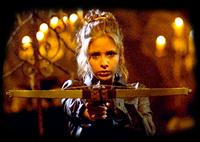In 1845, Boston shipyards were plagued by a
series of grisly murders. The attacks ended when a quiet
young woman arrived in town.
In 1893, in the Oakland Territory, a series of savage attacks
claimed the lives of 17 homesteaders. The murders stopped when a
young woman blacksmith passed through town.
The year is now 1997, and Sunnydale, California is on
the brink of ruin. Can another girl come to the rescue?
Buffy
The Vampire Slayer

As long as there have been demons, there has been the
Slayer. One girl in all the world, a Chosen one,
born with the strength and skill to hunt vampires and
other deadly creatures, to find them where they gather and to stop the
spread of their evil and the swell of their numbers.
When one Slayer dies, the next is called and trained by the Watcher.
A Watcher serves by finding the next Slayer, leading
her on her path. It is the destiny of the Watcher to guide the Slayer.
Down through the ages, the image of the vampire has
haunted the dreams of man. Around the world, many
differing legends of the vampire can be found.
In ancient egypt, it was believed that the dead would
sometimes return from the afterworld, walking the
night and where they would occasionally steal the
lives of unlucky villagers. In this world that viewed the
pharoahs as gods, the "undead" were just a fact of
life.
The vampire was viewed very differently in Southeast
Asia. The vampire was a demon who would visit
victims as they slept, draining their life essence. It
was widely believed that these monsters favored men
as their prey, leading to a bizarre custom in which
men would paint their nails and wear false eyelashes
when they slept. By changing their appearance they
believed they could trick the demons, saving their
lives in the process.
The more traditional version of the vampire legend
originates in the mountain villages of Eastern Europe.
Early recorded reports of vampire activity, sometimes
referred to as plagues, date back to the 17th century
Serbia. It seems the dead sometimes didn't stay
dead. Individuals recently deceased were seen
wandering the countryside. Like their Asian
counterparts, these undead beings would often visit
others while they slept, sometimes killing them. The
local lore referred to them as "nosferatu".
Unlike the cultured, cosmopolitan vampire that we
see in the movies, these vampires were ragged and
decomposed, and could turn their victims into
vampires themselves. Eventually the "vampire
epidemics" led to a practice in which bodies were
dug up and "killed" by a wooden stake driven through
the heart.
The vampire legend really begins to take its modern
shape in 1819, when The Vampyre was published.
Attributed to Lord Byron, the story was later credited
to Dr. Polidori, a sometime companion of Byron's.
The main character, Lord Ruthven, is an aristocrat
whose enchantment and manipulation of women sets
a tone that carries through to today: The vampire as
a sexual creature.
Probably the most famous story of the undead can
be found within the pages of Dracula, by Bram
Stoker. It is Stoker's concept of the vampire -
debonair, regal, predatory - that we have seen in the
movies. It is this vampire that we have come to know.
Anne Rice wrote of a slightly different vampire. A
vampire capable of emotion, longing, even of pity. Her
vampires remembered their mortal lives, lived by a
code, and even fell in love.
Even though there are many views of the vampire and
its nature, one thing is certain: Mankind has been
obsessed with the undead for centuries. The legend
of the vampire lurks in the shadows of our
imaginations, filling our hearts with fear.
PICTURES
Back to Main

